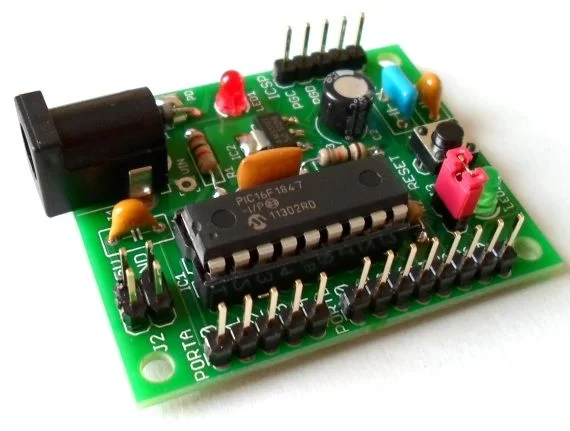This is an improved version of my 18-pin PIC16F series breadboard module that I have used in many of my PIC tutorials and projects published in this website. The new version has got a +5V power supply regulator on-board and a 2.1mm female barrel jack for DC input from a wall adapter. The 18-pin PIC16F series microcontrollers are still very popular among hobbyists and beginners because of their compact size, low cost, and simplicity.
The PIC16F1847 is the latest release in this series and is equipped with lot more peripherals and enhanced features than its predecessors. This breakout board will be helpful for rapid prototyping with the PIC16F1847 microcontroller. Since the predecessors of PIC16F1847 share the same pin configuration, this board can also be used with popular PIC16F84A, PIC16F628A, and PIC16F88 microcontrollers of the same series.
The key features of PIC16F1847 microcontroller are summarized here.
- Enhanced Mid-range Core with 49 Instruction, 16 Stack Levels
- 14 KB of Flash Program Memory with self read/write capability, 1KB of RAM, 256 bytes of EEPROM
- Internal 32MHz oscillator
- Integrated Capacitive mTouch Sensing Module
- Data Signal Modulator Module
- MI2C, SPI, EUSART w/auto baud
- 2 ECCP & 2 CCP (Enhanced/Capture Compare PWM)
- Comparators with selectable Voltage Reference
- 12 Channel 10b ADC with internal Fixed Voltage Reference
- 25mA Source/Sink current I/O
- Four 8-bit Timers (TMR0/TMR2/TMR4/TMR6)
- One 16-bit Timer (TMR1)
- Extended Watchdog Timer (EWDT)
- Enhanced Power-On/Off-Reset
- Brown-Out Reset (BOR)
- In Circuit Serial Programming (ICSP)
- On Board In-Circuit Debug
- Wide Operating Voltage (1.8V – 5.5V)
- Low Power PIC16LF182x/4x variants (1.8V – 3.6V)
- Standby Current (PIC16LF1847): 30 nA @ 1.8V, typical
Due to these attractive features, the PIC16F1847 is very suitable for small to medium scale applications where not too many I/O resources are required and small size is advantageous.
Circuit diagram of the board


